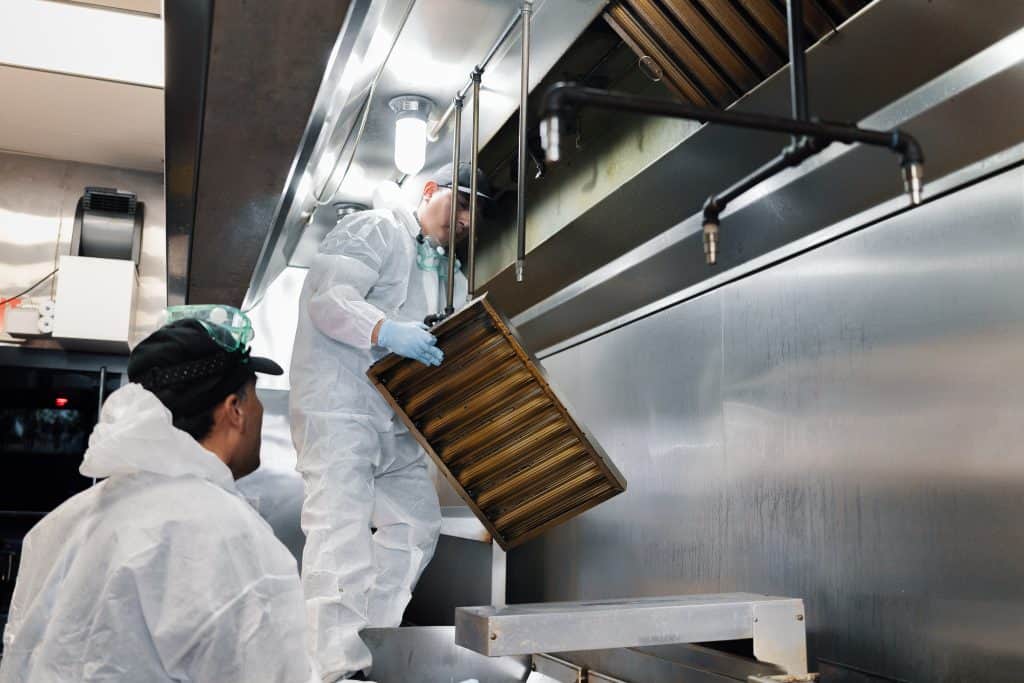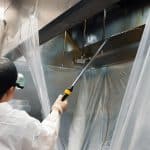
When you run a restaurant or commercial kitchen, safety, cleanliness, and compliance aren’t optional — they’re essential. One of the most overlooked but critical safety tasks is commercial hood cleaning. Without it, grease buildup can turn your exhaust system into a fire hazard, reduce airflow, and put your business at risk of shutdowns or fines.
In this guide, we’ll explain everything you need to know about commercial hood cleaning: why it’s required, how often to do it, what the cleaning process includes, and how it keeps your kitchen running safely and efficiently.
What Is Commercial Hood Cleaning?
A commercial kitchen hood (sometimes called a range hood or exhaust hood) sits above your cooking appliances to capture smoke, heat, and grease-filled vapors. Over time, these vapors create a sticky, flammable coating inside:
- The hood canopy
- Grease filters
- Ductwork running to the roof
- The exhaust fan pulling air out of your building
Commercial hood cleaning is the deep cleaning process that removes grease and debris from all these parts — not just the visible surfaces — to meet fire codes and safety standards.
Why Commercial Hood Cleaning Is Critical
1. Fire Prevention
Grease is extremely flammable. According to the National Fire Protection Association (NFPA), most restaurant fires originate in cooking equipment and quickly spread through greasy hood systems. Regular cleaning drastically reduces this risk.
2. Code Compliance
Local fire marshals and health inspectors follow NFPA 96 guidelines, which require professional hood cleaning at specific intervals. Non-compliance can mean fines, insurance issues, or business closure.
3. Better Indoor Air Quality
A clean hood and exhaust system efficiently remove smoke, steam, and odors — making your kitchen safer and more comfortable for employees.
4. Energy Savings
Grease buildup forces fans and HVAC systems to work harder. Clean systems run more efficiently and reduce energy costs.
Recommended Hood Cleaning Frequency
| Kitchen Type | Cleaning Frequency |
|---|---|
| High-volume (fast food, 24/7 diners, BBQ) | Every 3 months |
| Moderate (casual or fine dining) | Every 6 months |
| Low-volume (churches, seasonal kitchens) | Once a year |
| Solid fuel cooking (wood, charcoal) | Monthly |
Remember: insurance companies or inspectors can require more frequent service if your cooking produces heavy grease.
What Happens During Professional Commercial Hood Cleaning
When you hire TruShine Services for commercial hood cleaning, here’s what happens:
- Full System Inspection
Our certified technicians inspect the hood, ductwork, and fan for grease buildup and damage. - Work Area Protection
Cooking equipment and floors are covered with fireproof sheeting to keep your kitchen clean. - Filter Cleaning
Grease filters are removed and soaked in powerful but eco-safe degreasers. - Hood & Duct Degreasing
We use scraping, steam cleaning, and high-pressure washing to remove grease from the entire system. - Fan & Roof Cleanup
Exhaust fans and grease containment systems are cleaned to protect your roof and improve airflow. - Polish & Final Wipe-Down
Visible hood surfaces are polished for a professional, like-new appearance. - Compliance Report
We provide a service sticker and a detailed report for inspectors and insurance providers.
DIY Hood Cleaning vs. Professional Service
Surface cleaning and filter washing are good daily habits for staff, but professional hood cleaning is required to reach the deep, hidden ductwork where fire hazards start. Certified cleaners:
- Use specialized degreasers and steam equipment
- Access roof fans and vertical ducts safely
- Provide documentation for insurance and inspectors
- Reduce liability and risk of fire
Choosing a Commercial Hood Cleaning Company
When selecting a provider, ask:
- Are they NFPA 96 compliant?
- Do they carry liability insurance?
- Can they show before/after photos?
- Do they offer flexible cleaning schedules (overnight/closed hours)?
- Do they use eco-friendly degreasers?
TruShine Services meets all these standards — providing professional, eco-safe commercial hood cleaning that keeps your business worry-free.
Frequently Asked Questions
How long does hood cleaning take?
Usually 3–6 hours, depending on grease buildup and system size.
Do I need to close my kitchen?
We often clean overnight or during off-hours to minimize downtime.
Will I get proof of cleaning?
Yes — we provide photos, reports, and a service sticker for your hood.
Cost of Commercial Hood Cleaning
Costs vary by system size and grease levels:
- Small kitchens: $250–$400
- Medium: $400–$800
- Large/high volume: $1,000+
Routine service keeps costs predictable and avoids expensive emergency cleanings.
Why TruShine Services Is the Trusted Choice
At TruShine Services, we specialize in commercial hood cleaning, fryer filtration, and complete exhaust maintenance. We help you:
- Reduce fire risk
- Stay compliant with inspectors and insurance
- Operate safely and efficiently
- Use eco-safe cleaning solutions
📞 Call 678-751-8871
🌐 Visit trushineservice.com to book your service today.
Read more here:
Why Certified Hood Cleaning Protects Your Business (NFPA 96 Explained)
5 Things Restaurant Owners Should Focus on for Fire Safety
The Fry360 Advantage: Saving Money & Extending Oil Life
Top 7 Mistakes Restaurants Make Before a Fire Inspection
Consistent Cleaning Costs Less Than Emergency Repairs



